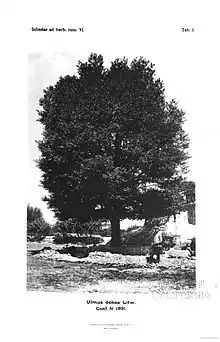Ulmus 'Densa'
The elm cultivar Ulmus Densa was described from specimens growing near Ashkabad as U. densa Litv. in Schedae ad Herbarium Florae Rossicae (1908).[1] Litvinov, reporting it growing wild in the mountains of Turkestan, Ferghana, and Aksu, as well as in cultivation, considered it a species, a view upheld by the Soviet publications Trees and Shrubs in the USSR (1951)[2] and Flora of Armenia (1962),[3] and by some current plant lists.[4][5][note 1] Other authorities take it to be a form of U minor, distinctive only in its dense crown and upright branching.[6][7][8] The Moscow State University herbarium gives (2020) Ulmus minor as the "accepted name" of U. densa Litv..[9][10]
| Ulmus 'Densa' | |
|---|---|
 'Densa' | |
| Genus | Ulmus |
| Cultivar | 'Densa' |
| Origin | C. Asia |
Litvinov considered U. minor 'Umbraculifera', with its "denser crown and more rounded form", a cultivar of U. densa,[6] calling it U. densa var. bubyriana. Rehder (1949) and Green (1964), ignoring reports of the wild form, considered U. densa a synonym of 'Umbraculifera'.[11][12] The U. densa photographed by Meyer in Aksu, Chinese Turkestan on his 1911-12 expedition does not appear to be the tidy grafted cultivar 'Umbraculifera' and was said to be named 'Seda'.[13][14] Zielińksi in Flora Iranica (1979) considered 'Umbraculifera' an U. minor cultivar.[15]
In its natural range U. densa overlaps with U. pumila. The extent of hybridization between the two is not known.
Description
Litvinov noted that the tree "differed little from U. glabra Mill." [:U. minor] except in its erect branches and dense oblong crown.[16] The leaves were "generally smaller" and the branches "smooth and lighter in colour". As with the hybrid U. × androssowii, its compact branch structure helps the tree conserve moisture.[17]
Pests and diseases
Not known.
Cultivation
Litvinov said that U. densa was "widely cultivated" in gardens in Turkestan. It is one of a number of elms known locally as 'karagach' or 'karagatch' [:'black tree' = elm].[18][19][20] In western Europe U. densa Litv. was distributed by Hesse's Nurseries, Weener, Germany, in the 1930s.[21]
 Dense-branched elm, upright form, Turkestan, c.1900
Dense-branched elm, upright form, Turkestan, c.1900 Dense-branched elm, spreading form, Turkestan, c.1900
Dense-branched elm, spreading form, Turkestan, c.1900 Dense-branched elm (left), Turkestan, c.1912
Dense-branched elm (left), Turkestan, c.1912
Notable trees
A large, well-grown specimen stands in Dushanbe Botanic Gardens, Tajikistan (2019).[22][23]
Cultivars
These include one of the oldest of elm cultivars, 'Umbraculifera', and a number of elms introduced to the West by the Späth nursery of Berlin.
Meyer (1912) identified three cultivars of U. densa: 'Stamboul', 'Kitaisky' and 'Seda'.[24][14]
Hybrid cultivars
The tree, or its cultivar form 'Umbraculifera', has hybridised with U. pumila to produce U. × androssowii.
Accessions
None known.
Notes
- Ulmus densa was one of two elm "species" determined by Litvinov; the second, his Ulmus celtidea, has not been accepted by other authorities (Journal of the Arnold Arboretum, vol.19, 1938; p.264).
References
- Schedae ad Herbarium Florae Rossicae , VI. 163-165 (1908)
- Sokolov, S. Ya (1951). Деревья и кустарники СССР [Trees & Shrubs in the USSR] (in Russian). 2. Moscow. pp. 504–505.
- Takhtajan, Armen Leonovich (1962). Флора Армении [Flora of Armenia] (in Russian). 4. Yerevan. pp. 341–342.
- The Plant List: Ulmus densa Litv., accessdate: December 14, 2016
- Tropicos: Name - Ulmus densa Litv., accessdate: December 14, 2016
- Elwes, Henry John; Henry, Augustine (1913). The Trees of Great Britain & Ireland. 7. p. 1893.
- De Langhe, Jan (7 April 2016). Vegetative key to species European cultivation (Ulmaceae) (PDF). Ghent: Ghent University Botanical Garden. p. 5. Retrieved 18 December 2016.
- Plantarium: Ulmus densa - Галерея субтаксонов - Плантариум (in Russian), accessdate: December 18, 2016
- Moscow State University herbarium, Specimen MW0591858, plant.depo.msu.ru
- Moscow State University herbarium, Specimen MW0591857, plant.depo.msu.ru
- Alfred Rehder (1949). "Bibliography of cultivated trees and shrubs hardy in the cooler temperate regions of the Northern Hemisphere". Arnold Arboretum of Harvard University. p. 142.
- Green, Peter Shaw (1964). "Registration of cultivar names in Ulmus". Arnoldia. Arnold Arboretum, Harvard University. 24 (6–8): 41–80. Retrieved 16 February 2017.
- Meyer's photograph (5675) of Ulmus densa Turkestan. Aksu, Turkestan. February 1911
- Meyer's photograph (5676) of Ulmus densa Turkestan. Aksu, Turkestan. February 1911
- J. Zielińksi, 'Ulmaceae', Flora Iranica, ed. K. H. Rechinger (Graz, 1979)
- Photograph captioned U. densa, uses.plantnet-project.org
- World Digital Library: Elm Trees. Samarkand, accessdate: December 18, 2016
- Rickmers, W. Rickmer, The Duab of Turkestan, a physiographic sketch and account of some travels (Cambridge, 1913), p.172
- Lansdell, Henry, Through Central Asia (London, 1887), p.464
- Voeikov, Aleksandr Ivanovich, Le Turkestan Russe (Paris, 1914), p.68
- Hesse, Hermann Albert (1932). Preis- und Sortenliste. pp. 96–97. Retrieved 18 January 2018.
- U. minor / Ulmus densa Litv. www.plantarium.ru
- Google Maps: Dushanbe Botanic Gardens - Google Maps (May 2019), accessdate: August 21, 2019
- Meyer, F. N. (1912). Seeds and plants imported during the period from January 1 to March 31, 1912: Inventory No.30, Nos 32829–32831. Bureau of Plant Industry - Bulletin No. 282. Washington, Government Printing Office, 1913.
External links
- efloras.org: U. densa Litv. (illustrations 10 to 14)
- Specimen MW0591858 "Moscow State University herbarium" Sheet labelled "type specimen", U. densa; samarae and new leaves (1896)
- "Specimen - P06881058". Collection: Vascular plants (P). Muséum national d’Histoire naturelle, Paris (France). Sheet labelled Ulmus densa Litv.; USSR, 1955
- "Herbarium specimen - E00405655". Herbarium Catalogue. Royal Botanic Garden Edinburgh. Sheet labelled Ulmus densa Litv.; specimen from Kazvin, Iran (1948)
- "Herbarium specimen - E00405656". Herbarium Catalogue. Royal Botanic Garden Edinburgh. Sheet labelled Ulmus densa Litv.; specimen from Iraq (1957)
- "Herbarium specimen - E00034376". Herbarium Catalogue. Royal Botanic Garden Edinburgh. Sheet labelled Ulmus densa Litv.; samara specimen from Isfahan, Iran (1948)
- "Specimen - P05538970". Collection: Vascular plants (P). Muséum national d’Histoire naturelle, Paris (France). (top left-hand specimen) Field elm leaves from Kurrum valley, Afghanistan (1879)